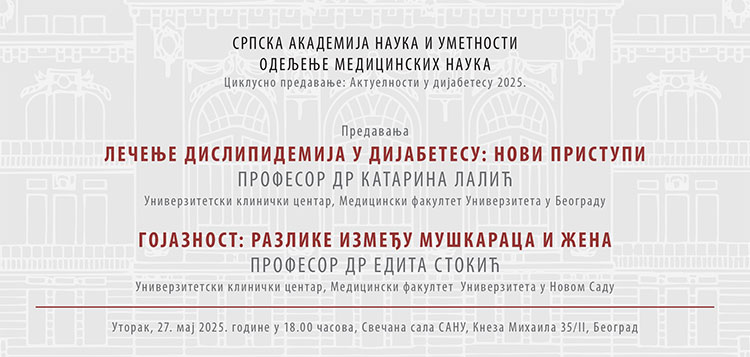Two lectures in the ongoing lecture series ’Updates in Diabetes 2025’
As part of the lecture series ’Updates in Diabetes’, two lectures will be delivered on Tuesday, 27 May, at 6 p.m. at the SASA Grand Hall. First, Professor Katarina Lalić, MD, will give a lecture titled ‘The Treatment of Dyslipidemia in Diabetes: New Approaches’ and Professor Edita Stokić will lecture on the topic ‘Obesity: The Difference between Men and Women.’
Prof. Dr Katarina Lalić emphasises that numerous studies conducted in recent years clearly state that cardiovascular diseases (CVD) are a major cause of increased morbidity and mortality in individuals with diabetes. Among the contributing factors, dyslipidemias play a particularly significant role in the development of atherosclerosis in diabetic patients.
‘The most frequent lipid disorder in diabetes is characterised by elevated triglyceride (Tg) levels and reduced HDL cholesterol, while LDL cholesterol may not appear significantly elevated compared to non-diabetic individuals. However, in diabetes, there are qualitative changes of LDL particles—becoming small and dense—which makes them more susceptible to oxidation, thereby increasing the risk of atherosclerosis,’ she explains.
The lecture abstract concludes that in recent years, several new therapeutic agents have been developed, including inhibitors of apolipoprotein C-III, angiopoietin-like proteins 3, 3/8, and 4, as well as fibroblast growth factor-21 (FGF-21) analogues. These treatments effectively reduce triglycerides and, notably, residual cholesterol—precisely the types of lipid abnormalities most prevalent in diabetes.
In the abstract of her lecture titled ‘Obesity: Differences between Men and Women,” Professor Edita Stokić, MD, discusses the sex-specific differences in body composition, fat distribution, and metabolism, noting that men have greater lean body mass, while women possess a higher percentage of fat mass.
The lecture abstract specifies that men usually possess a central, abdominal distribution of fat tissue, whereas women tend to accumulate more peripheral, subcutaneous fat. The higher volume of intra-abdominal fat in men is associated with a range of metabolic complications, including elevated insulin levels after meals, increased free fatty acids, impaired lipid and lipoprotein metabolism, and a heightened risk of type 2 diabetes and cardiovascular disease due to accelerated atherosclerosis. The distribution of peripheral subcutaneous fat more common in women and is less strongly linked to the development of cardiovascular complications related to obesity if compared to the central distribution of fat. However, when considering the comorbidities of obesity, it is relevant to note that type 2 diabetes and cardiovascular diseases are still more frequently observed in men than in women.
Professor Stokić underscores the need for further research into sex differences in the origin, progression, and pathophysiology of obesity, including the development of comorbidities and the appropriate use of pharmacotherapy and treatment strategies in order to define optimised, personalised approaches to obesity management.
A live stream of the event is available at LIVE STREAMING

